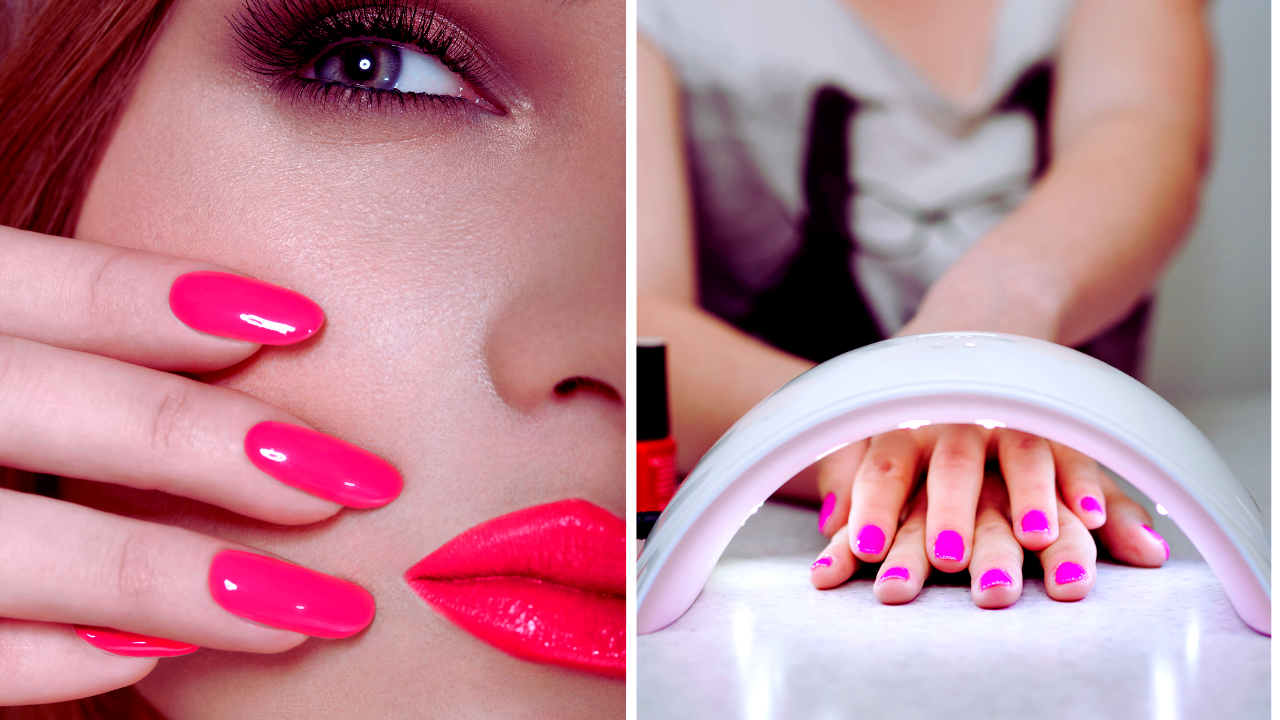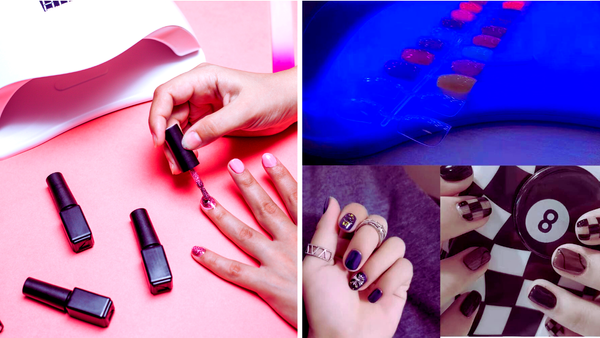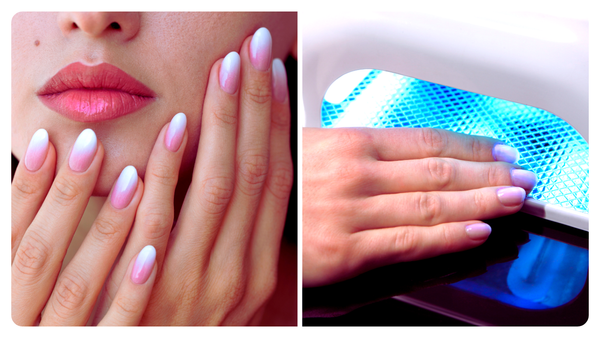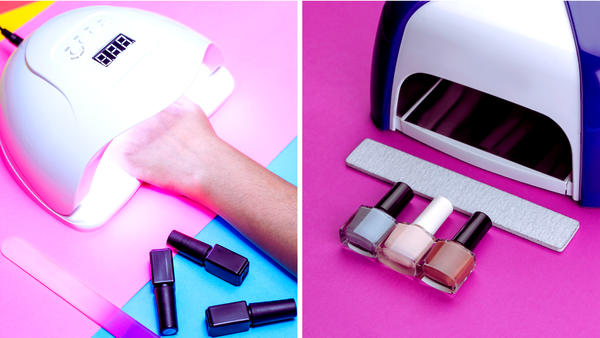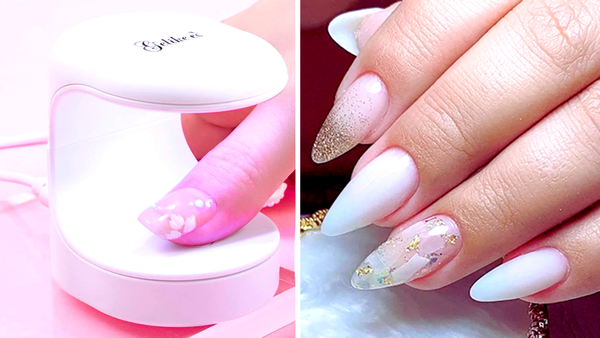Is UV light good for your nails? With the allure of lasting gel manicures comes this pivotal question. This article assesses the health implications of UV lamps for your nails, providing expert advice and practical tips to ensure your nail routine is safe.
Key Takeaways
- UV lamps are essential for setting gel polish in manicures. They employ a chemical reaction with UVA light to create a durable, glossy finish, but alternatives like LED lamps emitting less UV radiation are also used.
- Frequent use of UV nail dryers can lead to skin damage similar to that caused by tanning beds, with risks including DNA mutations and premature aging, which has raised concerns among dermatologists and health professionals.
- Protective measures such as applying broad-spectrum SPF to hands, wearing fingerless UV protective gloves, and considering alternatives like dip powders, nail stickers, and traditional manicures without UV light can mitigate risks associated with UV exposure during gel manicures.
Delving Into UV Light Use in Gel Manicures
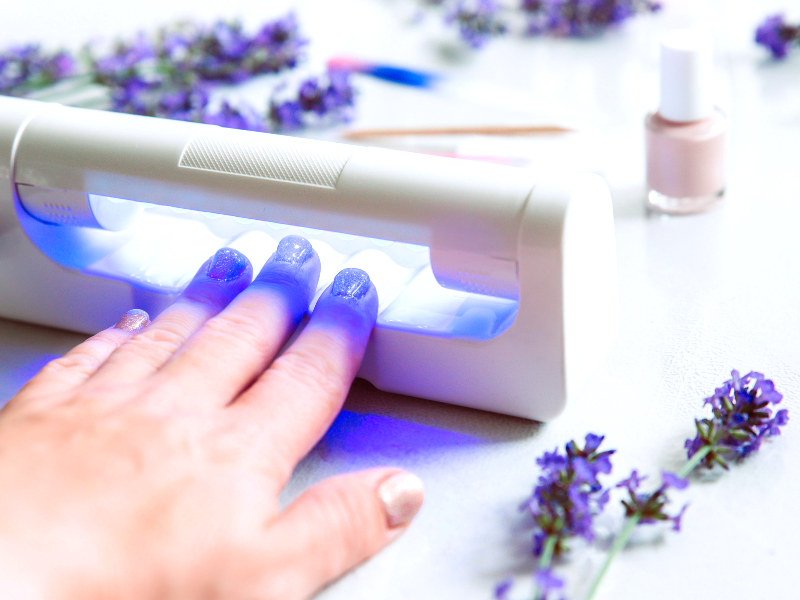
Gel manicures have transformed the nail industry, offering durability and gloss to outlast traditional nail polish. But with great beauty comes great scrutiny, particularly concerning the UV light required to set the gel polish into its signature rock-hard finish. The secret behind that enviable manicure is a chemical reaction.
UV lamps, also called UV lights, are integral to this beauty ritual. They emit light that causes photoinitiators within the gel polish to absorb the energy and begin a polymerization reaction, bonding monomers to create that hard, glossy surface you adore.
Understanding UV Technology in Nail Care
Delve deeper into the science, and you’ll find that not all lights are equal. While the fear of ultraviolet light is often associated with harmful effects, the UV lamps used in nail care predominantly emit UVA light, considered safer than their UVB or UVC counterparts. This light spectrum effectively sets gel polish, ensuring your nails are dry and ready to dazzle in minutes.
Yet, it’s not just about UV lamps anymore; LED lamps have entered the scene, promising to cure specific gel polishes even faster, though still emitting a trace amount of UV radiation.
The Attraction of Gel Nails
So why do we flock to gel nails despite the UV question? The answer is in the polish’s unparalleled resilience and shine. The polymerization process not only ensures that your gel manicure won’t chip or dull for at least two weeks, but it also provides a luster that looks freshly applied day after day. Imagine the convenience of going about your daily tasks without the fear of a single chip or the need for frequent touch-ups. That’s the practical beauty of gel nails, rooted in the science of UV light.
Evaluating the Safety of UV Nail Dryers
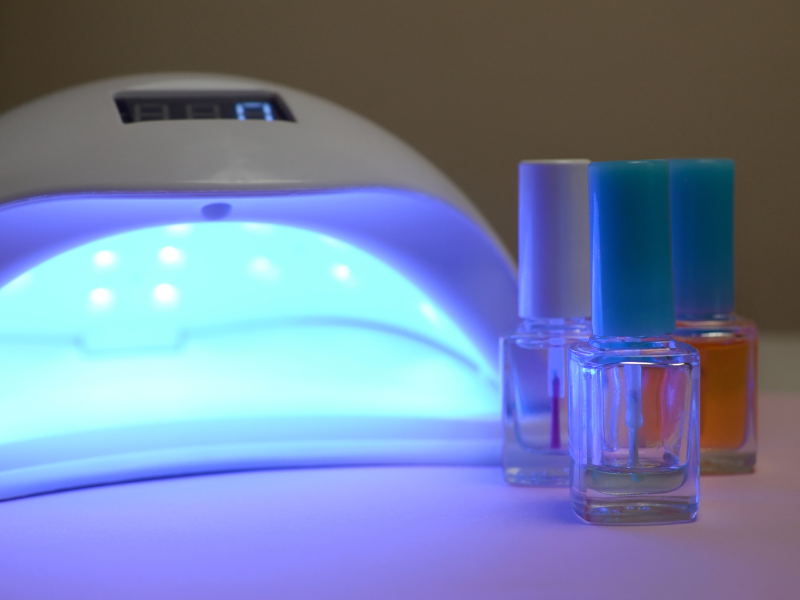
The convenience of gel nails, however, raises an important question: Are UV nail dryers safe for regular use? Studies indicate that the ultraviolet light from these devices can lead to cellular damage akin to that seen in skin cancers. After just 20 minutes under UV lamps, significant cell death has been observed, and the risks only increase with repeated use. This has sparked a debate on the frequent use of UV nail dryers and the potential damage they could inflict over time, including DNA mutations and premature skin aging.
Protective Measures Against UV Exposure
While the risks associated with UV light in gel manicures can’t be ignored, there are effective ways to protect yourself. Applying broad-spectrum sunscreen to your hands before stepping into the nail salon is a simple yet powerful measure against UV radiation. Additionally, reducing the frequency of gel manicures to special occasions can significantly reduce your overall exposure, helping maintain the health of your skin and nails.
Using Broad Spectrum SPF
Healthcare professionals urge using a broad-spectrum sunscreen with an SPF of at least 30 on hands as a pre-manicure ritual. This type of sunscreen is designed to shield the skin from UVA and UVB rays, which cause skin aging, sunburn, and potentially skin cancer.
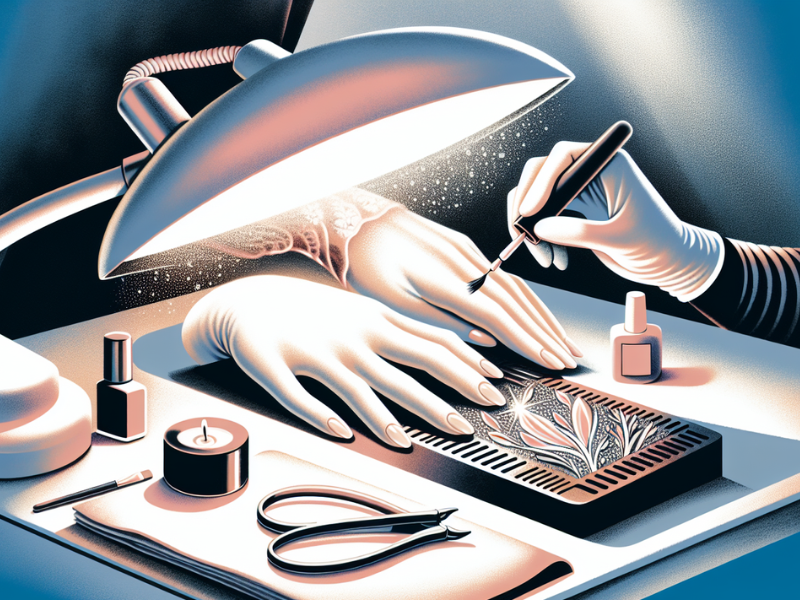
Choosing the Right Gloves
Another layer of defense comes in the form of fingerless gloves, which many nail salons now offer. These gloves protect the skin while exposing the nails for effective treatment. When choosing UV protective gloves, look for a high Ultraviolet Protection Factor (UPF), ideally UPF 50, to block out 98% of UV rays. These gloves are not only functional but also made from materials that ensure comfort during your manicure experience.
Alternatives to UV-Cured Gel Manicures
With awareness growing about the potential risks of UV exposure during gel manicures, many are seeking alternatives that offer the same polished look without the need for UV light. Natural air drying is the safest option, eliminating the need for drying lamps. For those who are environmentally conscious, water-based nail polishes provide an eco-friendly alternative free from harsh chemicals and the need for UV light. The Dazzle Dry system is another innovative solution, delivering a durable manicure that rivals traditional polishes and hybrids without requiring light curing or soaking for removal.
Trendy Dip Powders
Dip powders are another trendy option that has been gaining popularity. Applied using an adhesive polish, the nails are then dipped in colored powder. This process does not involve LED or UV light, making it an attractive alternative for those concerned about UV exposure. These powders come in various color options and add strength to the nails, offering a finish that can last as long as traditional gel manicures. However, it’s worth noting that the removal process for dip powders can be a bit more involved, requiring soaking much like acrylics.
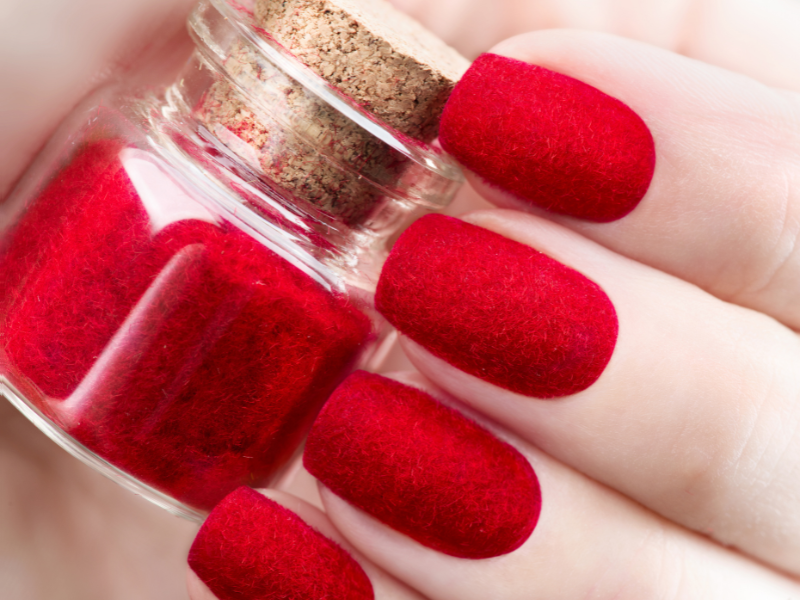
Stick-On Style: Nail Stickers
Nail stickers are a fun and fuss-free alternative that provides an instant manicured look. These peel-and-stick applications are simple to use and come in many designs and colors. When applied correctly, they can last up to two weeks, making them a convenient option for those on the go.
Back to Basics: Regular Manicures
For those who prefer to keep things classic and maintain their natural nails, regular manicures with traditional nail polish are a safe and time-honored choice. Modern formulations of classic nail polish have evolved, omitting harmful ingredients and incorporating beneficial nutrients for the nails and skin. This option allows for the enjoyment of a diverse color palette without the worry of UV light exposure.
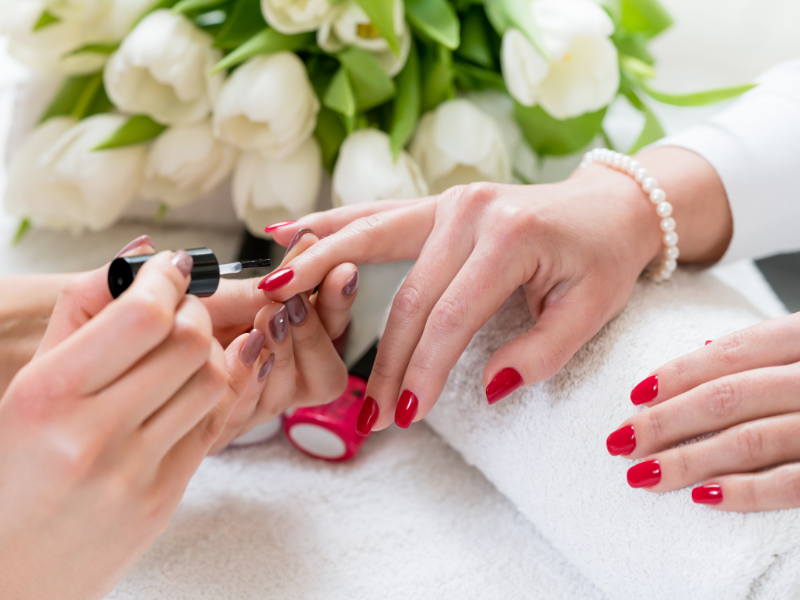
Recognizing Warning Signs
Recognizing the warning signs of UV damage is crucial for maintaining healthy nails. White spots or patches on the nails, increased brittleness, and a yellowish tinge are among the early indicators that your nails may be suffering from the effects of UV light exposure. These signs, coupled with faster skin aging and loss of skin elasticity, highlight the need for caution and care when opting for gel manicures.
Checking Your Nail Plate
After removing gel polish, closely examining your nail plate can provide insight into any potential UV damage. Changes in skin color around the nail bumps underneath the nail plate, and any discoloration of the surrounding skin should be monitored. The weakening of nails following gel applications is often due to improper preparation or removal, indicating that the damage may go beyond superficial skin changes.
Monitoring Skin Health
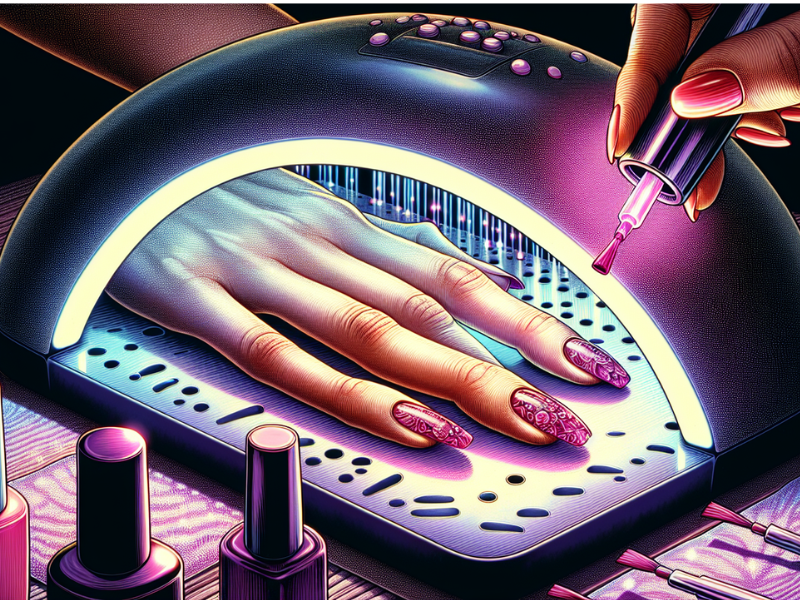
The health of your skin around the nails is equally important. Here are some signs to look out for:
- Dark, brown, black, or red lines that extend back to the cuticle can be alarming signs of potential damage from UV light exposure.
- An increase in nail ridges or the appearance of grooves.
- Changes in skin pigmentation around the nail beds.
If you notice any of these signs, it is important to prompt further investigation.
Summary
In the mesmerizing glow of UV nail light, it’s easy to overlook the potential risks our nails and skin face. However, with the knowledge we’ve shared today, you can make informed decisions about your manicure routine, ensuring style and safety. Remember to consider protective measures such as applying sunscreen, wearing UV gloves, and staying vigilant for warning signs of damage. Embrace alternatives to UV-cured gel manicures that align with your lifestyle and health priorities. By shining a light on manicure safety, you empower yourself to enjoy the beauty of well-manicured hands without compromising your well-being.
FAQ
Is there a significant difference between the UV light used in gel manicures and tanning beds?
Yes, there is a significant difference between the UV light used in gel manicures and tanning beds. UV nail dryers are designed for shorter, more localized exposure, while tanning beds cover the entire body and often involve longer sessions, increasing the risk of skin damage and cancer.
Can applying sunscreen protect my hands from UV damage during a gel manicure?
Yes, applying sunscreen with at least SPF 30 can effectively protect your hands from UVA and UVB radiation during a gel manicure. It's an important step in nail care.
Are there any signs I should be aware of that might indicate damage from UV exposure during gel manicures?
Be aware of white spots, increased brittleness, yellowing, or changes in skin color or texture around the nails, as these can indicate UV damage. Monitor your nails regularly for these signs of potential harm.
